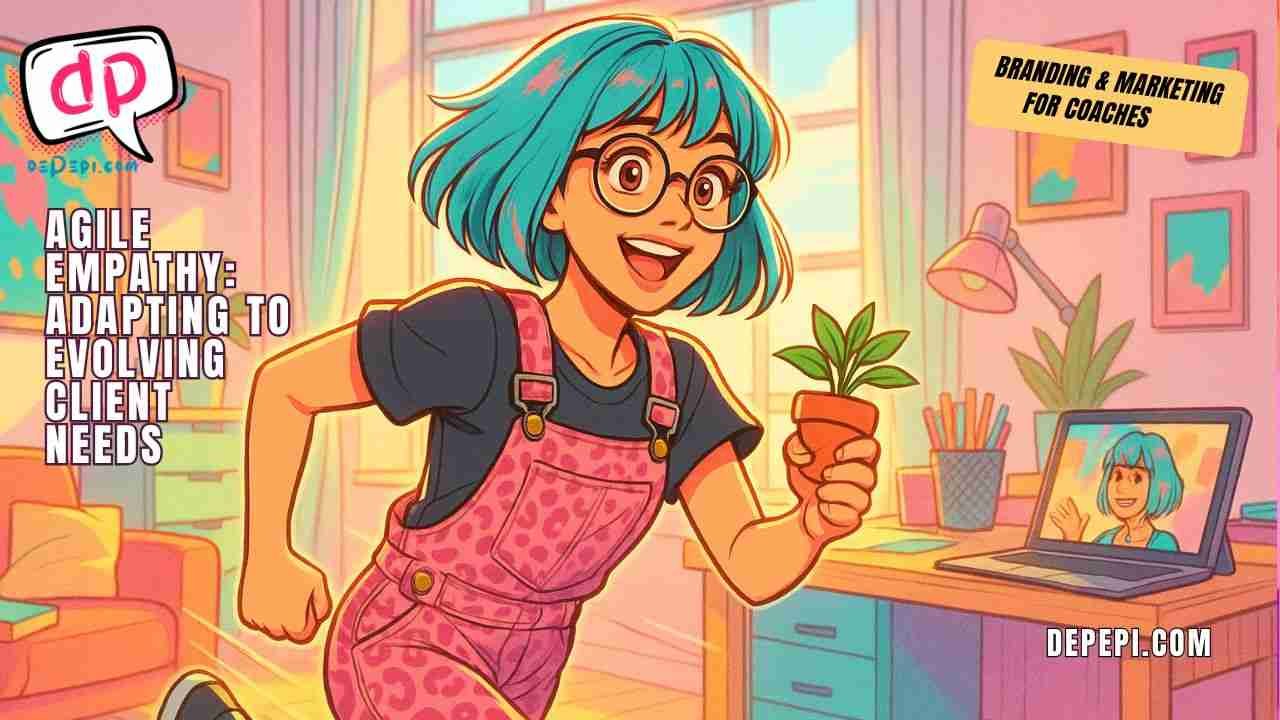Agile Empathy: Adapting to Evolving Client Needs

The coaches who thrive don’t just understand their clients once; they evolve with them continuously. That’s “agile empathy”.
You spend months perfecting your messaging and nail your ideal client avatar. Soon, your content starts resonating beautifully, and new clients are booking calls, and everything feels aligned.
Then, seemingly overnight, something shifts, and your engagement drops. Discovery calls feel off. The language that used to land perfectly now feels… stale. Your clients are nodding politely, but the spark is gone.
What happened? Did you lose your touch? Did your messaging suddenly become irrelevant?
Neither. What happened is that your clients evolved, and your empathy didn’t evolve with them.
This is the hidden challenge that separates thriving coaches from struggling ones: the ability to practice agile empathy—continuously adapting your understanding, messaging, and approach as your clients’ needs shift and change.
Rigid Empathy vs Agile Empathy
Here’s the controversial truth that most marketing experts won’t tell you: Constant adaptation may dilute a coach’s core message or brand, leading to inconsistency and potential confusion among prospective clients.
This fear keeps many coaches stuck in static empathy, where they understand their clients once and then rely on that understanding until it stops working. They’re terrified that evolving their message means losing their brand identity or confusing their audience.
But here’s what’s really happening: The world is changing faster than ever. Your clients’ challenges are evolving, so their priorities are shifting. Their language is adapting because their fears are transforming.
The coach who insists on static empathy, who clings to last year’s client insights, becomes increasingly irrelevant, no matter how perfectly they understood their clients initially.
Meanwhile, the coach who practices agile empathy —the one who continuously evolves their understanding while maintaining their essence —stays magnetically connected to their clients’ real, current experience.
What Agile Empathy Really Means
Agile empathy isn’t about changing your message every week or chasing every trend. It’s about maintaining a dynamic, responsive relationship with your clients’ evolving needs while staying true to your core mission.
Think of it like this: Your core values and transformation methodology remain constant (that’s your North Star). But your understanding of how those values and methods apply to your clients’ current reality? That evolves continuously.
- Static empathy says, “My clients struggle with work-life balance.” Agile empathy says, “My clients’ relationship with work-life balance is evolving—from seeking balance to seeking integration, from managing time to managing energy, from external boundaries to internal alignment.”
- Static empathy says, “I help anxious entrepreneurs.” Agile empathy says, “I help entrepreneurs navigate anxiety, and I notice their anxiety is shifting from ‘Am I good enough?’ to ‘How do I maintain my values while scaling?’ to ‘How do I lead authentically in uncertain times?'”
The Three Pillars of Agile Empathy
Continuous Listening
Agile empathy starts with never assuming you fully “know” your clients. Even if you’ve worked with similar clients for years, each new conversation is an opportunity to discover something fresh about their evolving experience.
What This Looks Like
- Regularly asking existing clients: “What’s changed for you since we started working together?”
- Paying attention to shifts in the language they use to describe their challenges
- Noticing when familiar problems start showing up in new ways
- Staying curious about generational, cultural, and societal shifts affecting your client base
Pattern Recognition Across Time
Agile empathy requires looking for patterns not just across different clients, but across different time periods with the same client segments.
What This Looks Like
- Comparing client intake forms from six months ago to current ones
- Tracking how the same demographic’s concerns have evolved
- Noticing seasonal or cyclical changes in client needs
- Identifying emerging themes before they become obvious trends
Responsive Adaptation
This is where many coaches get stuck. They recognize the changes but are unsure of how to adapt without compromising their brand identity.
What This Looks Like
- Updating your messaging to reflect current client language while maintaining your core values
- Evolving your content themes to address emerging concerns
- Adjusting your service offerings to meet shifting needs
- Refining your client avatar based on new insights
The Key
Adapt your application, not your foundation. Your core methodology and values remain constant, but how you communicate and apply them evolves.
The Agile Empathy Framework
The Empathy Audit (Monthly)
Current Client Check-In
- Send a brief survey to existing clients: “What’s your biggest challenge right now that wasn’t a concern six months ago?”
- Review recent session notes for new themes or language patterns
- Notice what topics are generating the most energy (positive or negative) in sessions
Market Listening
- Monitor social media conversations in your niche for emerging themes
- Pay attention to what other coaches and thought leaders are discussing
- Notice shifts in the questions you’re getting in discovery calls
Language Evolution Tracking
- Keep a document of how your clients describe their challenges over time
- Note when familiar problems start being described in new ways
- Track which metaphors and analogies resonate most currently
Pattern Analysis (Quarterly)
Trend Identification
- Look for themes that have emerged across multiple clients
- Identify concerns that are becoming more or less prominent
- Notice demographic or generational differences in how problems are experienced
Impact Assessment
- Determine which changes are temporary fluctuations vs. lasting shifts
- Assess how these changes affect your core service offerings
- Evaluate whether your current messaging still resonates
Opportunity Mapping
- Identify gaps between evolving client needs and current market solutions
- Spot opportunities to lead conversations rather than follow them
- Recognize areas where your expertise can address emerging concerns
Strategic Adaptation (Quarterly)
Messaging Evolution
- Update your core messaging to reflect current client language and concerns
- Refresh your content themes to address emerging needs
- Revise your client avatar to include new insights
Service Refinement
- Adjust your coaching approach to address evolving challenges
- Consider new service offerings that meet emerging needs
- Update your onboarding process to reflect current client priorities
Content Strategy Updates
- Create content that addresses new concerns using evolved language
- Develop resources that bridge old and new client needs
- Share insights about the evolution you’re witnessing in your client base
Agile Empathy in Action
Social Media Evolution
Static Approach
Continue posting the same type of content that worked last year
Agile Approach
Notice that your audience is responding differently to specific topics, and adjust your content mix accordingly.
Discovery Call Adaptation
Static Approach
Use the same discovery call script and questions regardless of when the call takes place.
Agile Approach
Regularly update your discovery questions to reflect current client concerns and language.
Email Marketing Evolution
Static Approach
Continue sending the same types of emails with the same messaging.
Agile Approach
Regularly refresh your email content to address evolving client needs and use current language.
The Risks and How to Navigate Them
Brand Confusion
- The fear: If you keep evolving your messaging, people won’t know what you stand for.
- The reality: People are more confused by outdated messaging that doesn’t reflect current reality.
- The solution: Evolve your application while maintaining your core values and methodology. Communicate the evolution transparently.
Chasing Every Trend
- The fear: You’ll become a trend-chaser with no authentic voice.
- The reality: Agile empathy is about responding to genuine client evolution, not following marketing trends.
- The solution: Base adaptations on direct client feedback and observed patterns, not industry buzz.
Losing Existing Clients
- The fear: Current clients will feel abandoned if you evolve your focus.
- The reality: Clients appreciate coaches who grow and evolve with them.
- The solution: Include existing clients in your evolution process. Ask for their input and explain the adaptations you’ve made.
Strategic Integration
Practicing agile empathy is incredibly powerful for staying connected with your clients’ evolving needs, but it’s most effective when integrated into a comprehensive marketing strategy that can flex and adapt while maintaining consistency.
Find more about this and other strategies in my Branding and Marketing for Coaches course.
Branding and Marketing for Coaches (Life, Health, Wellness)
Common Agile Empathy Mistakes to Avoid
Waiting Too Long to Adapt
Many coaches notice changes but wait until their results significantly decline before adapting. By then, they’ve lost momentum and trust.
Hint
Make small, continuous adaptations rather than waiting for major overhauls.
Adapting Without Data
Some coaches make changes based on one or two client comments rather than identifying genuine patterns.
Hint
Look for patterns across multiple clients and time periods before making significant adaptations.
Changing Everything at Once
When coaches finally recognize the need to evolve, they sometimes change their entire message, confusing their audience.
Hint
Make incremental changes while maintaining core brand elements.
Not Communicating the Evolution
Coaches sometimes evolve their messaging without explaining the evolution to their audience, leaving people confused about the changes.
Hint
Share your insights about how your clients’ needs are evolving and how you’re adapting to serve them better.
Next Steps
The coaching industry is becoming increasingly sophisticated, and clients are becoming more discerning about who they choose to work with. The coaches who thrive will be those who demonstrate not just initial understanding, but ongoing attunement to their clients’ evolving needs.
This isn’t about abandoning your core message or chasing every trend. It’s about maintaining a living, breathing relationship with your clients’ reality, one that honors both their growth and your own.






